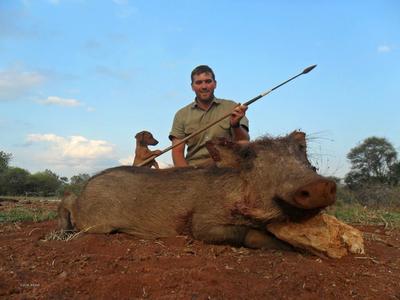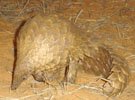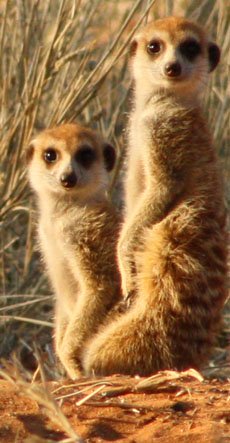For more information about our hunting safaris, don’t hesitate to reach out and contact us!
My warthog hunted with a spear...
by Willem Pretorius
(Kingdom of Bahrain)
My first warthog with a spear
This spear is an original specimen given to me as a gift by a grateful Bushmen tracker in the Kalahari-Ghansi district in Botswana where, after a real nail biting leopard follow-up, I’ve shot and killed the leopard mere milli-seconds before it could jump on the tracker.
This was another story….…
After seeing the pictures of my uncle hunting with his big cold steel boar spear, and not to be outdone, I’ve thus decided to also try my hand at hunting a warthog with my own spear.
I've took refuge in an old feeding trough krip where the warthogs frequently came to drink water.
Some good ones came in, but they were just too far away for an accurate throw.
After a considerable time, just when I contemplated to leave, three young warthogs came in and start drinking about 10 m from where I sat concealed in waiting!
My heart start racing and I could not believe my luck!
On the spot I decided to take this opportunity, and after some planning and concentration of how to quickly stand up and my arm movement at the same time, I burst into action and let fly at the nearest warthog.
The spear hit the warthog broadside on but a little high, just above the heart, and it frantically rushed away into the bush. After the adrenalin rush and when I've calmed down some, I went to retrieved my spear.
I next put my two excited hunting dog/trackers on its spoor. Though small in size, these Jack Russell / Dachshund crossbreeds more than make up for size with their brave attitude and superb hunting instinct
Like lightning they were off on the spoor and before long after about 50 m in the bush, they were in a huge fight with this by now very aggressive wounded young warthog boar many, many times their own size and weight!
Boy, how I wish I could show you all what real bravery is all about.....
I waited for the right moment in the melee and dust, and then let fly with my spear again.
When the spear blade hit the warthog behind the ear, it dropped like a stone.
Actually I've aimed for just behind the shoulder, sure that at such a short distance there is no way that I could miss such a big target! lol
Well, it’s definitely not one of my biggest warthogs that I've hunted so far, but surely one of my most exciting warthog hunts up to date!
Now, this young warthog is going to make a very tasty meal roasted over the campfire!
Well done, young Nimrod
–Bertus Pretorius!
Meaning of "Uitspan"
'Uitspan' is an Afrikaans word that means place of rest.
When the Boer settlers moved inland in Southern Africa in the 1800's, they used ox carts. When they found a spot with game, water and green grass, they arranged their ox carts into a circular laager for protection against wild animals and stopped for a rest.
They referred to such an action of relaxation for man and beast, as Uitspan.
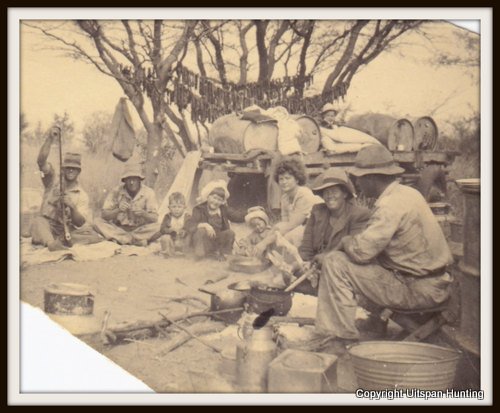
(Picture above of our ancestors.)
Did you know?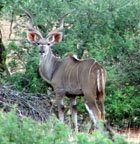 Greater Southern Kudus are famous for their ability to jump high fences. A 2 m (6.56 ft) fence is easily jumped while a 3 m (9.84 ft) high fence is jumped spontaneously. These strong jumpers are known to jump up to 3.5 m (11.48 ft) under stress. |
Did you know? Some animals have one sense more than man!The flehmen response is a particular type of curling of the upper lip in ungulates, felids and many other mammals. This action facilitates the transfer of pheromones and other scents into the vomeronasal organ, also called the Jacobson's Organ. Some animals have one sense more than man!The flehmen response is a particular type of curling of the upper lip in ungulates, felids and many other mammals. This action facilitates the transfer of pheromones and other scents into the vomeronasal organ, also called the Jacobson's Organ.This behavior allows animals to detect scents (for example from urine) of other members of their species or clues to the presence of prey. Flehming allows the animals to determine several factors, including the presence or absence of estrus, the physiological state of the animal, and how long ago the animal passed by. This particular response is recognizable in males when smelling the urine of a females in heat. |
